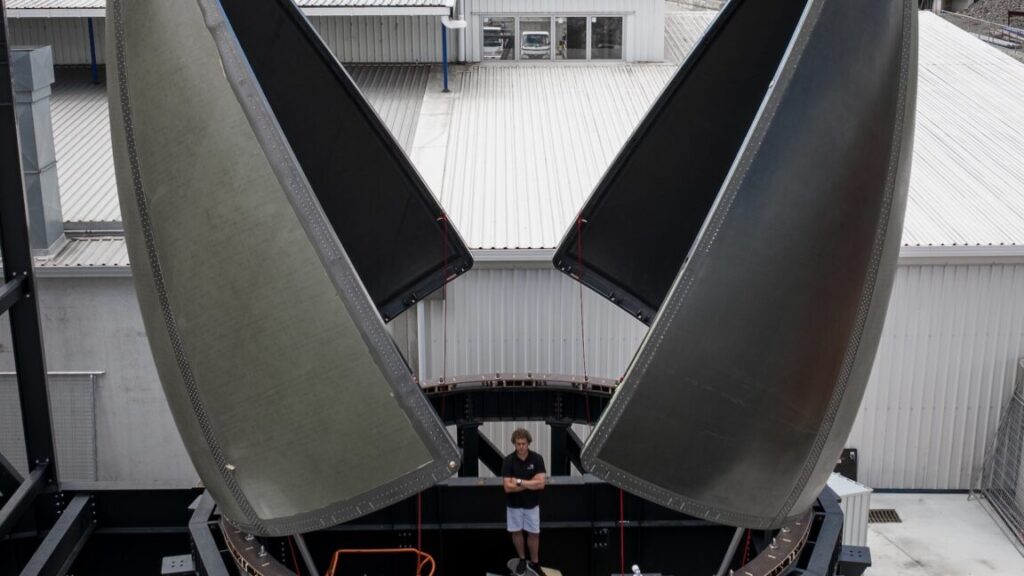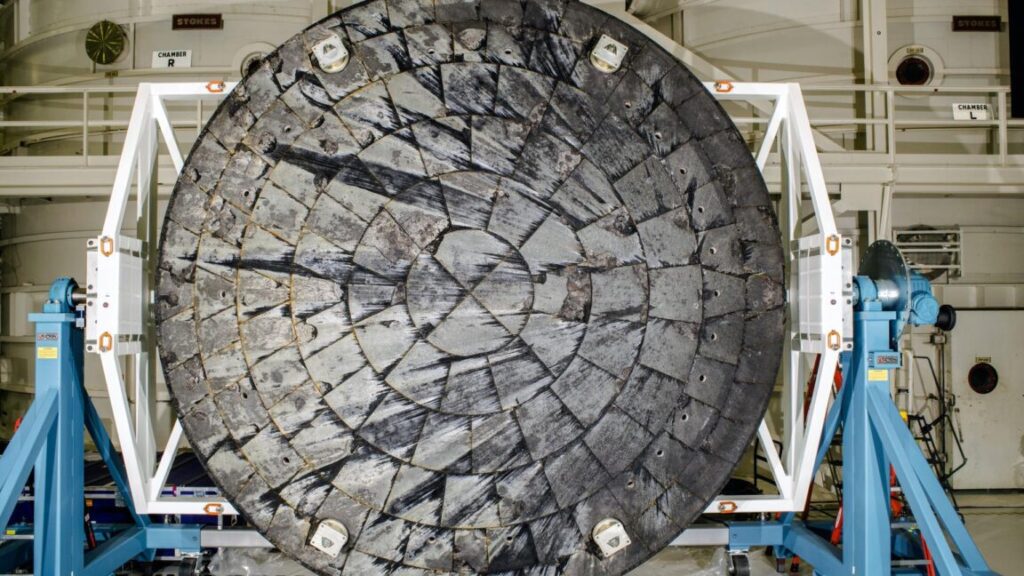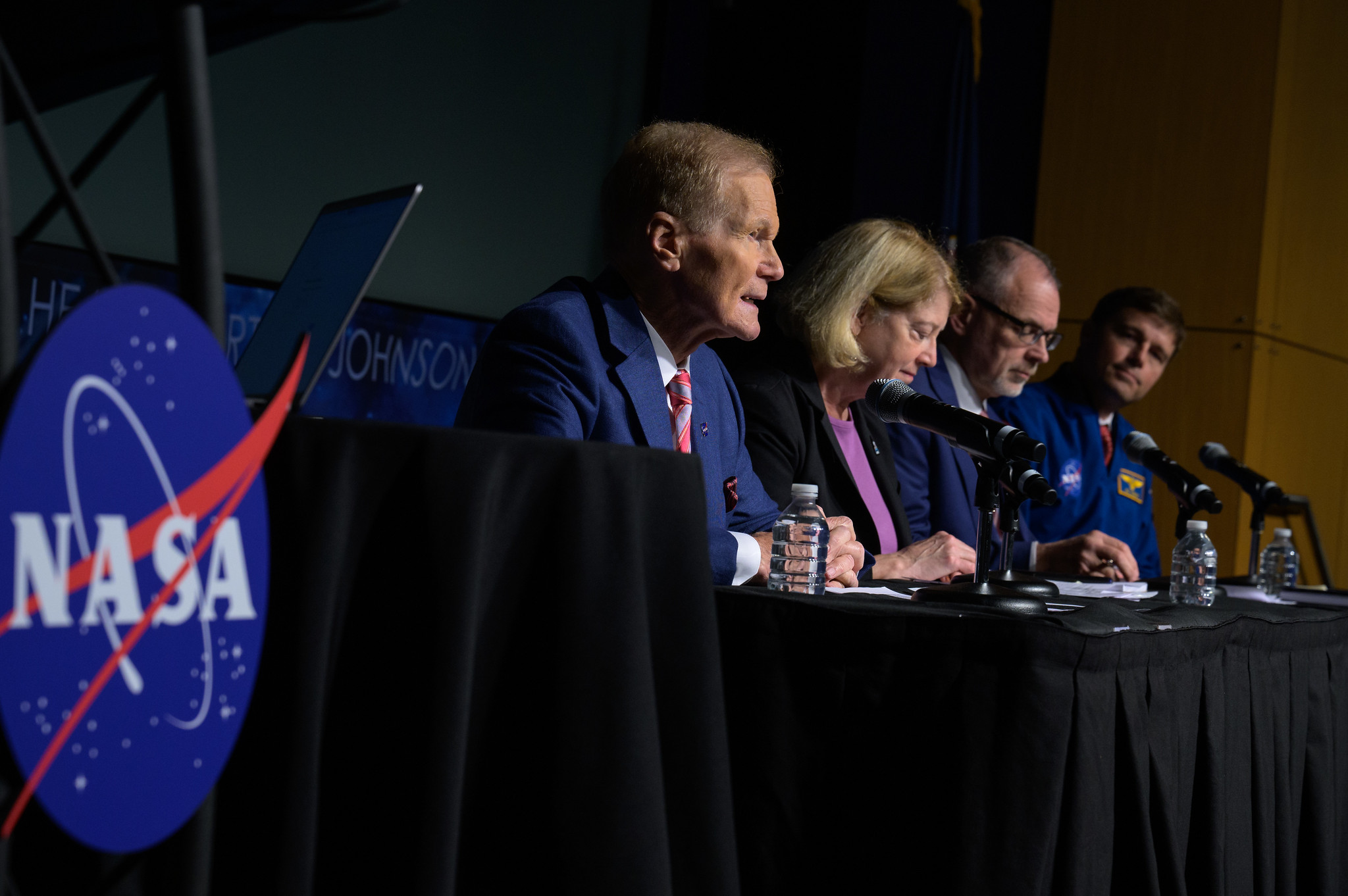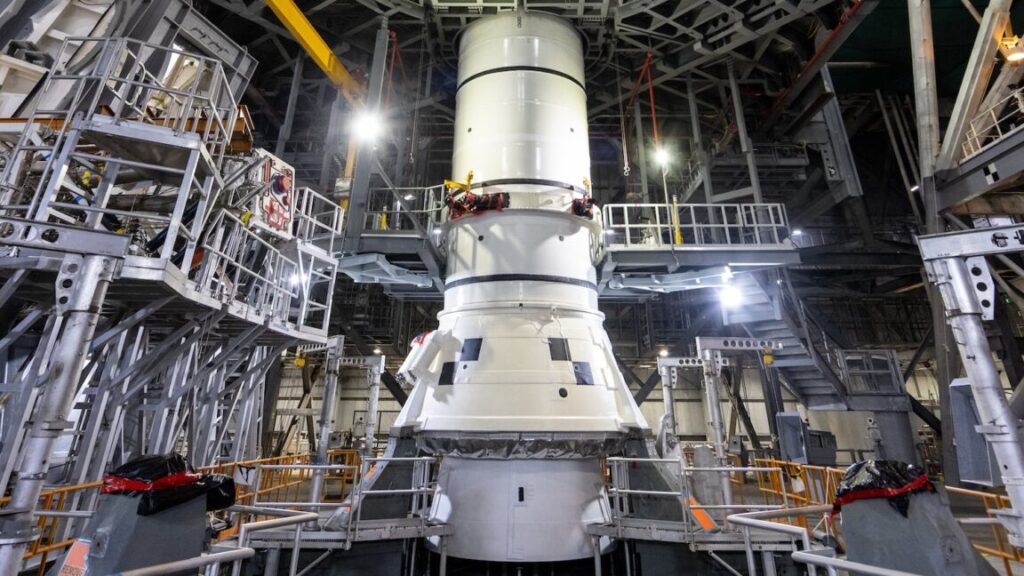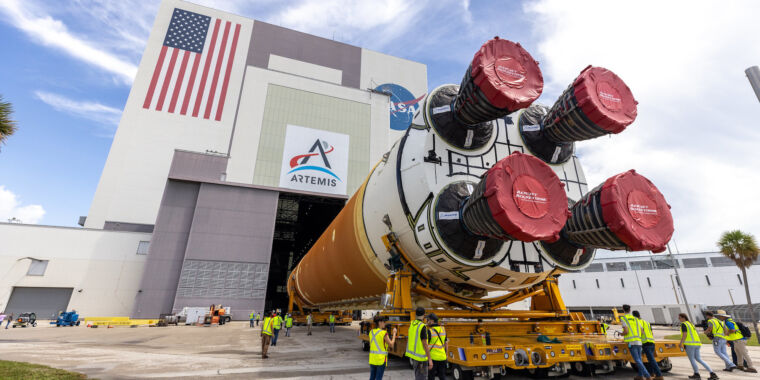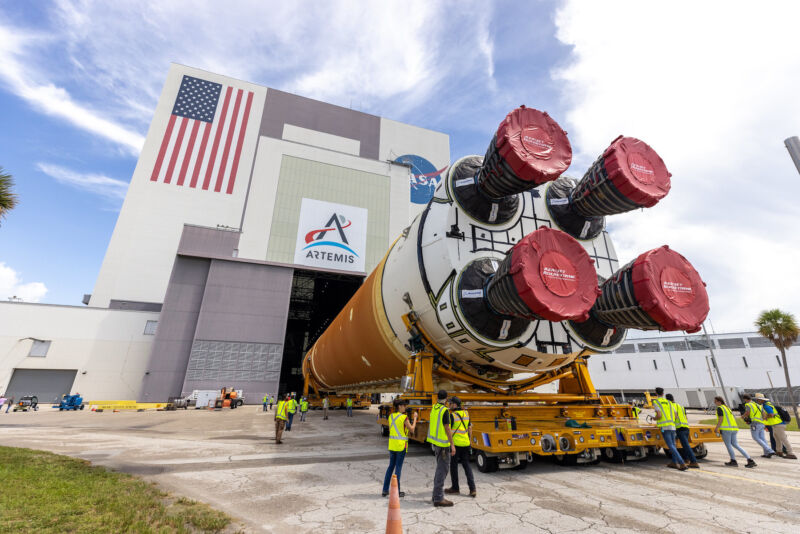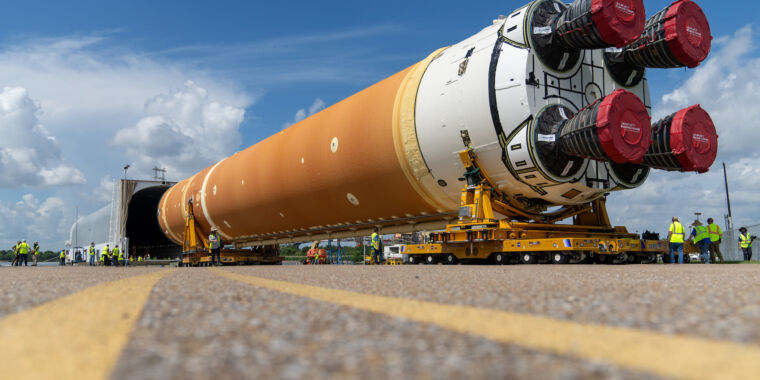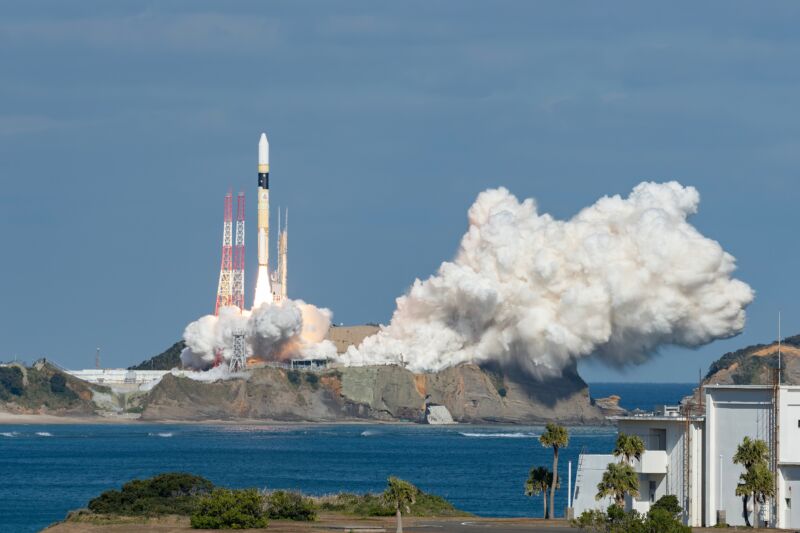Rocket Report: Starship will soon fly again; Gilmour has a launch date
One Falcon 9 launched an Intuitive Machines lunar lander, an asteroid prospector, and a NASA science probe.
Peter Beck, Rocket Lab’s founder and CEO, stands inside a test version of the “Hungry Hippo,” a nickname used to describe the clamshell-like nose cone of the Neutron rocket’s first stage booster. The fairing will open in flight to release Neutron’s second and payloads to continue into orbit, then close as the booster comes back to Earth for recovery. Credit: Rocket Lab
Welcome to Edition 7.33 of the Rocket Report! Phew, what a week for Rocket Lab! The company released a bevy of announcements in conjunction with its quarterly earnings report Thursday. Rocket Lab is spending a lot of money to develop the medium-lift rocket Neutron rocket, and as we’ll discuss below, a rocket landing platform and a new satellite design. For now, the company is sticking by its public statements that the Neutron rocket will launch this year—the official line is it will debut in the second half of 2025—but this schedule assumes near-perfect execution on the program. “We’ve always been clear that we run aggressive schedules,” said Peter Beck, Rocket Lab’s founder and CEO. The official schedule doesn’t quite allow me to invoke a strict interpretation of Berger’s Law, which states that if a rocket’s debut is predicted to happen in the fourth quarter of a year, and that quarter is six or more months away, the launch will be delayed. However, the spirit of the law seems valid here. This time last year, Rocket Lab targeted a first launch by the end of 2024, an aggressive target that has come and gone.
As always, we welcome reader submissions. If you don’t want to miss an issue, please subscribe using the box below (the form will not appear on AMP-enabled versions of the site). Each report will include information on small-, medium-, and heavy-lift rockets as well as a quick look ahead at the next three launches on the calendar.

Australian startup sets a launch date. The first attempt to send an Australian-made rocket into orbit is set to take place no sooner than March 15, the Australian Broadcasting Corporation reports. Gilmour Space Technologies’ launch window announcement marks a major development for the company, which has been working towards a test launch for a decade. Gilmour previously hoped to launch its test rocket, Eris, in May 2024, but had to wait for the Australian government to issue a launch license and airspace approvals for the flight to go forward. Those are now in hand, clearing the last regulatory hurdle before liftoff.
Setting expectations … Gilmour’s Eris rocket is made of three stages powered by hybrid engines consuming a solid fuel and a liquid oxidizer. Eris is designed to haul payloads of up to 672 pounds (305 kilograms) to low-Earth orbit, and will launch from Bowen Orbital Spaceport in Queensland on Australia’s northeastern coast. Gilmour said it would be “very lucky” if the rocket reached orbit on first attempt. “Success means different things for different people, but ignition and liftoff will be huge,” said James Gilmour, the company’s co-founder. (submitted by ZygP)
Blue Origin is keeping a secret. Blue Origin conducted the tenth crewed flight of its New Shepard suborbital vehicle Tuesday, carrying six people, one of whom remained at least semi-anonymous, Space News reports. The five passengers Blue Origin identified come from business and entertainment backgrounds, but in a break from past missions, the company did not disclose the identity of the sixth person, with hosts of the company webcast saying that individual “requested we not share his name today.” Photos released by the company before the launch, and footage from the webcast, showed that person to be a man wearing a flight suit with an “R. Wilson” nametag, and the NS-30 mission patch also included “Wilson” with the names of the other members of the crew. Not disclosing the name of someone who has been to space has little precedent.
Big names on NS-31 … Some of the passengers Blue Origin will fly on the next New Shepard crew mission lack the anonymity of R. Wilson. The next flight, designated NS-31, will carry an all-female crew, including music star Katy Perry, CBS host Gayle King, and Lauren Sánchez, a former journalist who is engaged to Blue Origin’s founder, Jeff Bezos. Blue Origin identified the other three passengers as Aisha Bowe, Amanda Ngyuen, and Kerianne Flynn. (submitted by EllPeaTea)
The easiest way to keep up with Eric Berger’s and Stephen Clark’s reporting on all things space is to sign up for our newsletter. We’ll collect their stories and deliver them straight to your inbox.
Virgin Galactic is still blowing through cash. Virgin Galactic reported a net loss of $347 million in 2024, compared to a $502 million net loss in 2023, with the improvement primarily driven by lower operating expenses, the company said this week in a quarterly earnings release. These lower operating expenses are tied to Virgin Galactic’s decision to suspend operations of its VSS Unity suborbital rocket plane last year to focus investment into a new series of suborbital spacecraft known as Delta-class ships. Virgin Galactic said cash and cash equivalents fell 18 percent from the same period a year ago to $178.6 million. Investors have been eager for details on when it would resume—and then ramp up—flights to increase sales and cash in on a backlog of around 700 ticket holders, Bloomberg reports.
March toward manufacturing … Virgin Galactic said it plans to start assembling its first Delta-class ship in March, with a first flight targeted for the summer of 2026, two years after it stopped flying VSS Unity. The Delta ships will be easier to recycle between flights, and will carry six paying passengers, rather than the four VSS Unity carried on each flight. Company officials believe a higher flight rate with more passengers will bring in significantly more revenue, which was reported at just $430,000 in the fourth quarter of 2024. (submitted by EllPeaTea)
Japanese customers seem to love Rocket Lab. While Rocket Lab is developing the larger Neutron rocket, the company’s operational Electron launch vehicle continues to dominate the market for dedicated launches of small satellites. Rocket Lab announced Thursday it signed a new multi-launch deal with iQPS, a Japan-based Earth imaging company. The new deal follows an earlier multi-launch contract signed with iQPS in 2024 and brings the total number of booked dedicated Electron launches for iQPS to eight.
Radar is all the rage … These eight Electron launches in 2025 and 2026 will help iQPS build out its planned constellation of 36 radar remote sensing satellites capable of imaging the Earth day and night, and through any weather. The new deal is one of the largest Electron launch agreements to date, second only to Rocket Lab’s ten launch deal with another Japanese radar constellation operator, Synspective, signed last year. (submitted by zapman987)

Falcon 9 launch targets Moon and asteroid. With two commercial Moon landers already on their way, Houston-based Intuitive Machines launched its second robotic lander atop a SpaceX Falcon 9 rocket Wednesday, CBS News reports. Given the on-time launch and assuming no major problems, the Athena lander is expected to descend to touchdown on a flat mesa-like structure known as Mons Mouton on March 6, setting down just 100 miles from the Moon’s south pole—closer than any other spacecraft has attempted. Intuitive Machines became the first company to successfully land a spacecraft on the Moon last year, but the Athena lander will pursue more complex goals. It will test a NASA-provided drill designed to search for subsurface ice, deploy a small “micro-rover,” and dispatch a rocket-powered drone to explore a permanently shadowed crater.
Hitching a ride … The Athena lander didn’t take up all the capacity of the Falcon 9 rocket. Three other spacecraft also rocketed into space Wednesday night. These rideshare payloads were AstroForge’s commercially developed Odin asteroid prospector to search for potentially valuable mineral deposits, NASA’s Lunar Trailblazer satellite to characterize lunar ice from a perch in lunar orbit, and a compact space tug from Epic Aerospace. (submitted by EllPeaTea)
This rocket got a visitor for the first time since 2009. Astroscale’s ADRAS-J mission became the first spacecraft (at least in the unclassified world) to approach a piece of space junk in low-Earth orbit, Ars reports. This particular object, a derelict upper stage from a Japanese H-IIA rocket, has been in orbit since 2009. It’s one of about 2,000 spent rocket bodies circling the Earth and one of more than 45,000 objects in orbit tracked by US Space Command. Astroscale, based in Tokyo, built and launched the ADRAS-J mission in partnership with the Japanese space agency as a demonstration to show how a commercial satellite could rendezvous with an object in orbit that was never designed to receive visitors.
Next steps … ADRAS-J worked like a champ, closing in to a distance of less than 50 feet (15 meters) from the H-IIA rocket as it orbited several hundred miles above the Earth. The rocket is a “non-cooperative” object representative of other large pieces of space junk, which Astroscale wants to remove from orbit with a series of trash collecting satellites like ADRAS-J. But this demo only validated part of the technology required for space debris removal. Japan’s space agency and Astroscale are partnering on another mission, ADRAS-J2, for launch in 2027 to go up and latch on to the same H-IIA rocket and steer it out of orbit toward a controlled reentry over the ocean.
An update on Falcon 9’s upper stage. SpaceX said that a Falcon 9 upper stage that reentered over Europe earlier this month suffered a propellant leak that prevented it from doing a controlled reentry, Space News reports. The upper stage was placed in orbit on a February 1 launch from Vandenberg Space Force Base in California. After deploying its payload of 22 Starlink satellites, the upper stage was expected to perform a burn to enable a controlled reentry over the ocean, a standard procedure on most Falcon 9 launches to low-Earth orbit. The stage, though, did not appear to perform the burn and remained in orbit. Its orbit decayed from atmospheric drag and the stage reentered over Europe on February 19. Debris from the Falcon 9 second stage, including composite overwrapped pressure vessels, fell in Poland, landing near the city of Poznań.
Higher than expected body rates … In an update posted to its website this week, SpaceX blamed the upper stage anomaly on a liquid oxygen leak. “During the coast phase of this Starlink mission, a small liquid oxygen leak developed, which ultimately drove higher than expected vehicle body rates,” SpaceX said. SpaceX aborted the deorbit burn and instead passivated the upper stage, a process where the rocket discharges energy from its batteries and vents leftover propellant from its tanks to minimize the risk of a break-up in orbit. This was the third incident involving a Falcon 9 upper stage in a little more than six months. (submitted by EllPeaTea)
Rocket Lab’s reveals “Return On Investment.” Rocket Lab’s Neutron rocket is designed for partial reusability, and the company unveiled Thursday an important piece of infrastructure to make this a reality. Neutron’s first stage booster will land on a modified barge named “Return On Investment” measuring around 400 feet (122 meters) wide, somewhat bigger than SpaceX’s drone ships used for Falcon 9 landings at sea. In order to prep the barge for rocket duty, the company is adding autonomous ground support equipment to capture and secure the landed Neutron, blast shielding to protect equipment during Neutron landings, and station-keeping thrusters for precise positioning. It should be ready to enter service in 2026. Rocket Lab also has the option to return the Neutron first stage back to the launch site when mission parameters allow the rocket to reserve enough propellant to make the return journey.
More news from Rocket Lab … Continuing the firehose of news from Rocket Lab this week, the company announced a new satellite design called “Flatellite” that looks remarkably similar to SpaceX’s Starlink satellites. The satellite is flat in shape, hence its name, and stackable to fit as many spacecraft as possible into the envelope of a rocket’s payload fairing. Rocket Lab said the new satellite “can be produced in high volumes and (is) tailored for large constellations, targeting high value applications and national security missions.” (submitted by zapman987)

The writing is on the wall for SLS. The lights may be starting to go out for NASA’s Space Launch System program. On Wednesday, one of the Republican space policy leaders most consistently opposed to commercial heavy lift rockets over the last decade—as an alternative to NASA’s large SLS rocket—has changed his mind, Ars reports. “We need an off-ramp for reliance on the SLS,” said Scott Pace, director of the Space Policy Institute at George Washington University, in written testimony before a congressional hearing about US space policy.
Not keeping Pace … A physicist and influential policy expert, Pace has decades of experience researching and writing space policy. He has served in multiple Republican administrations, most recently as executive secretary of the National Space Council from 2017 to 2020. He strongly advocated for the SLS rocket after Congress directed NASA to develop it in 2011. As part of his policy recommendations, Pace said NASA should seek to use commercial providers of heavy lift launch so that NASA can send “multiple” crew and cargo missions to the Moon each year. He notes that the SLS rocket is not reusable and is incapable of a high flight rate. Commercial options from SpaceX, Blue Origin, and United Launch Alliance are now available, Pace wrote.
The verdict is in for Starship Flight 7. SpaceX believes the spectacular break-up of Starship’s upper stage during its most recent test flight was caused by a harmonic response that stressed onboard hardware, leading to a fire and loss of the vehicle, Aviation Week reports. Higher-than-expected vibrations stressed hardware in the ship’s propulsion system, triggering propellant leaks and sustained fires until the test flight ended prematurely. The rocket broke apart and deposited debris over the Turks and Caicos Islands and the Atlantic Ocean, and forced dozens of commercial and private aircraft to delay their flights or steer into safer airspace.
Whole lotta shaking … SpaceX’s description of the problem as a harmonic response suggests vibrations during Starship’s climb into space were in resonance with the vehicle’s natural frequency. This would have intensified the vibrations beyond the levels engineers expected from ground testing. SpaceX completed an extended duration static fire of the next Starship upper stage to test hardware modifications at multiple engine thrust levels. According to SpaceX, findings from the static fire informed changes to the fuel feed lines to Starship’s Raptor engines, adjustments to propellant temperatures, and a new operating thrust for the next test flight, which could launch from South Texas as soon as Monday.
Next three launches
March 1: Kuaizhou 1A | Unknown Payload | Jiuquan Satellite Launch Center, China | 10: 00 UTC
March 2: Ceres 1 | Unknown Payload | Jiuquan Satellite Launch Center, China | 08: 10 UTC
March 2: Soyuz-2.1b | Glonass-K2 No. 14L | Plesetsk Cosmodrome, Russia | 22: 22 UTC

Rocket Report: Starship will soon fly again; Gilmour has a launch date Read More »
